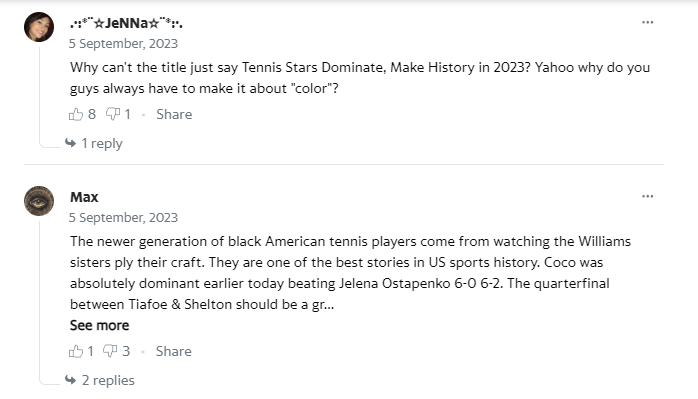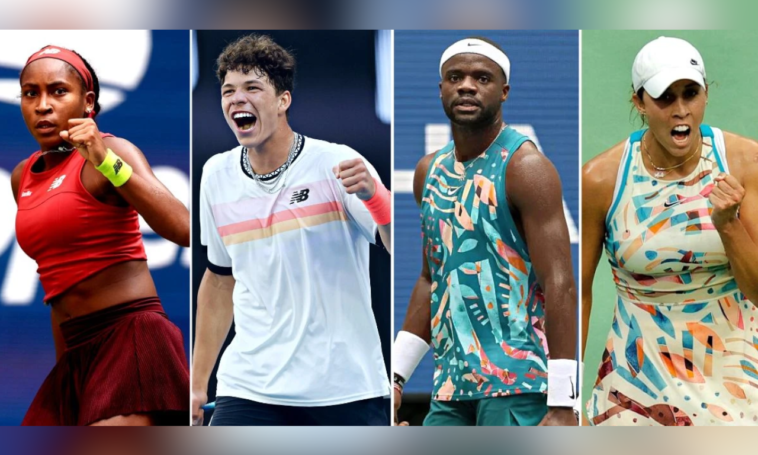Numerous news stories celebrated Serena Williams’s impact on tennis as a Black woman after she played the last game of her extraordinary career at the U.S. Open last year.
The emergence of new Black tennis talents in America, many of whom were influenced by Venus and Williams, is a major storyline at the 2023 U.S. Open, one year later.
The Grand Slam competition saw four Black American athletes—Coco Gauff, Frances Tiafoe, Madison Keys, and Ben Shelton—make it to the quarterfinals for the first time since the sport’s open era started in 1968.
Given that Gauff and Keys advanced to separate semifinal matches and faced different opponents, two Black American tennis players might face off in the U.S. Open women’s final.

Twenty-two years after the Williams sisters created history in 2001 by being the first two women of color to participate in the U.S. Open women’s final, their prospective encounter would occur.
Shelton will play in his first-ever Grand Slam singles semifinal on Friday against No. 2 seed Novak Djokovic on the men’s side. Her father, Bryan Shelton, was also a trailblazing Black American tennis player.
Shelton advanced to the semifinals after defeating Tiafoe in four sets on Tuesday in the quarterfinals. Martin Blackman, general manager of player development for the U.S. Tennis Association, called the match a “watershed moment” for American tennis.
It was the first time two Black men met at the U.S. Open in a men’s quarterfinal match.
“It made me think of the legacy and the pioneers and the people that had sacrificed and opened doors for all of us and created these opportunities for Ben and Frances and Coco and so many others,”
Blackman, a Black former professional tennis player, said on “Good Morning America,” as he watched Ben and Frances perform on Arthur Ashe Stadium, in a facility named after Billie Jean King, in a year that we’re celebrating 50 years of equal prize money. “It was a turning point for American tennis, of course, but it wasn’t the championship.”
Before the match, No. 10 seed Tiafoe spoke about his matchup with buddy Shelton as a “monumental moment.”
The Arthur Ashe Tennis Court, where the two players played, is named after the late tennis great and civil rights activist who won many championships, including Wimbledon and the U.S. Open and was the first Black person to accomplish so.
“A huge match on Arthur Ashe, featuring two players of color in the quarterfinals.” Tiafoe said during a news conference, “It’s a pretty monumental moment.” I’m looking forward to competing against him. I hope the fight is fantastic.”
According to Blackman, the rise of Andy Tiafoe, now ranked No. 10 in the world, illustrates the efforts made over the last twenty-plus years to change tennis from a mostly white country club sport to one available to everyone.
At the Junior Tennis Champions Center in College Park, Maryland, where his dad, an immigrant from Sierra Leone, worked in maintenance and construction, Tiafoe began playing tennis as a young child. Last year, Tiafoe made history as the first Black American man to reach the U.S. Open semifinals since Ashe in 1972.
For children in underprivileged neighborhoods, the USTA’s National Junior Tennis and Learning program offers tennis and educational possibilities; the JTCC is regarded as a center of excellence.
“Joining forces with the JTCC—where Frances got his start—is one of the most potent and significant things the USTA does, he continued.
“They are developing hundreds of kids every year, and that’s where Frances got his start,” Blackman said, referring to the JTCC in particular, where he had previously served as director.
“There are about 150 tennis and education programs nationwide, mostly in inner cities.”
When American tennis was at its lowest point, apart from the Williams sisters, in 2009, the USTA began a new strategy for player development, which is partly responsible for the current success fans see in players like Tiafoe, Gauff, Shelton, Keys, Taylor Townsend, Chris Eubanks, and others, according to Blackman.
To encourage more players from diverse backgrounds, the USTA started collaborating with private-sector instructors and hosting camps at the local, regional, and national levels.
In addition to assessing prospects, Blackman said that the camps served as a means of fostering ties between the players’ parents and coaches and provided knowledge.
Player development was not a predetermined process but based on each player’s specific demands and the understanding that no two players are the same.
According to Blackman, any American player under 26 who is rated in the top 100 today followed that new developmental route.
“As we build the house, we kind of look back to that 2009 to the end of 2019 period,” he said. We are now ecstatic to be enjoying the results of that labor.

Even with the greatest development efforts, Blackman understood that progress cannot be accomplished without representation.
He said, “We need our coaching community, just like our playing community, to look like America.” The USTA, he claimed, has placed a strong emphasis on internal diversification to hire more female, Black, and Hispanic coaches.
From a player’s perspective, Blackman asserts that the “Williams sister effect” has surely contributed to the rise of Black tennis players at all levels.
After a record-breaking, decades-long professional career that saw her win 23 Grand Slam singles championships, Serena Williams announced her retirement from tennis last year at 40.
Seven-time Grand Slam singles champion Venus Williams is still active on the professional tennis circuit at forty-three years old.
“Finally, families choose a sport or consider which sport to enter their daughter or son into because their attraction to the activity is the driving force behind their decision,” Blackman added. And it’s changed the game because so many girls of color have been drawn to the sport by the Venus and Serena influence.

“The last 20 years have been a trajectory-changing period,” he said. “Girls of color and girls in general, regardless of color, have been able to look up to Venus and Serena and see two authentic women who are strong Black champions and proud of who they are.” For it, there is no replacement.
Gauff, the young Black tennis sensation in America, reflected on how much Serena Williams had influenced youngsters like herself as she played her final match last year.
Speaking of Serena Williams, Gauff told NPR, “I never thought growing up that I was different because, you know, the No. 1 player in the world was somebody who looked like me.”
As a woman, especially a Black woman, in the world, you often have to make concessions. And I think that’s what Serena just showed me by watching her. Less was never acceptable to her. There was never a time in her life or work that I can recall when she gave up.”
Along with Black male players like MaliVai Washington and James Blake to Shelton’s father Bryan, who left his position as a record-breaking college tennis coach earlier this year to mentor his son’s professional career, Blackman claims that the Williams sisters have also made an impact on the men’s side of the sport.
Due to its increasing diversity, tennis has also grown more culturally significant, as seen by the appearance of tennis players on magazine covers and in Netflix series like “Breaking Point.”
Blackman noted that the current state of American tennis reminds him of the 1970s when Ashe was a dominating player but also a much better player on the circuit due to his lack of white teammates.
Tennis was “so cool and so relevant in the late ’70s,” according to Blackman. “The energy and momentum are the same, but there is a significant increase in diversity this time.”







GIPHY App Key not set. Please check settings
One Comment